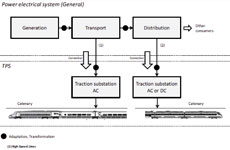
Categories
Publications
Current situation and prospects of electric traction systems used in High-Speed railways
26/6/2018

For their operation High-Speed railways use electric power systems with very specific characteristics and different from other electric consumers. The electric traction currently used in High-Speed networks is characterized by being very energy efficient. This is mainly due to the use of AC systems instead of DC systems.
On the other hand, the electrical systems used in High-Speed networks are a source of disturbances, both for the railway system itself and for external power supply networks (public grid). The traditional technologies developed in the past continue to be used in the new railway lines, especially in the case of having a sufficiently robust electrical network. On the other hand the expansion of the High-Speed in zones in which this network is not sufficiently powerful, has begun to introduce new solutions based on power electronics equipment. This technology, very implanted in the railway vehicles, has hardly had implantation in the railway infrastructure. The operational advantages of these equipments are several. In addition to the use of lower quality power grids (lower short-circuit power), they also introduce new improvements in traction energy collection. For example, the catenary neutral zones can be removed, the electrical parameters can be regulated and the system performance can be improved in case of operating in a degraded scenario (a problem electrical substation). Although current catenary power systems are quite efficient and operational, integrated operation with these power electronic equipment means that the final conditions improve.
Download paper »


